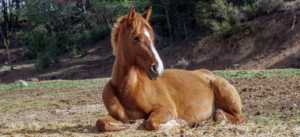 Out of Work Horses: Management Strategies. How can you safely shift a horse from near-daily exercise to a life of leisure, even if temporary? Appropriate nutrition is a key consideration during this transition.
Out of Work Horses: Management Strategies. How can you safely shift a horse from near-daily exercise to a life of leisure, even if temporary? Appropriate nutrition is a key consideration during this transition.
Moving from stall to pasture:
Has your horse been kept in the barn all or most of the time while actively training and showing? Make the switch to pasture gradually. Start with half an hour of grazing two or three times a day. Make sure to provide plenty of hay when the horse is in the stall. Increase pasture time in half-hour increments for several days. Next, add an hour or two to each grazing session until the horse is able to be out all the time.
The horse’s digestive system is complex. Any horse relocated abruptly from stall to full pasture is at high risk for colic or laminitis. At any time during the shift, if the hooves feel warm to the touch, or the horse shows signs of pain or reluctance to move, put the horse in the stall and contact your veterinarian immediately.
Some horses are so sensitive to the sugars in grass that they can never have unlimited access to pasture. These equines can still benefit from a few weeks or months of full or partial turnout if they are muzzled or placed in a drylot with an adequate supply of hay.
Feeding:
To stay in show condition and perform the work he has been asked to do, your horse has probably been given top-quality hay and one or more feedings of concentrate (pellets or sweet feed) daily. Without the demands of training, he will require the same basic nutrients but will need much less energy. Ideally, you can take a week or two to taper his schedule, slowly decreasing both his work and his grain ration.
Gradually switching to a balancer pellet or a vitamin and mineral supplement will supply essential nutrients without the calories found in a concentrated feed. Kentucky Equine Research has developed several vitamin and mineral supplements. Continue to give your horse whatever dietary supplements he is accustomed to, such as hoof and joint products, but check ingredients to avoid over supplementation when feeding more than one product.
You should still provide hay whenever the horse spends time in the stall. Something to munch on will alleviate boredom, keep gastric ulcers at bay, and prevent gorging on grass at the next turn-out. Free-choice access to water and salt is essential at all times.
Pasture safety:
Before turning your horse out the first time, take a quick tour of the fenceline and field to check for debris, holes, loose boards or wire, and insecure gate latches, and correct any problems before using the field. Bell boots and galloping boots can help guard against injury as the horse gets used to his freedom.
Depending on the season, fly spray will give a few hours of relief from insects; consider using mesh fly sheets, face masks, and leg covers for longer-lasting comfort. Changing seasons may eliminate insect problems, but horses with white faces may need sun protection year-round. Sunscreen or fly masks with muzzle extensions can prevent painful sunburn.
Hoof care:
Many people feel it is advantageous for horses to go barefoot if they are going to be inactive for several months. Will your horse benefit from having his shoes pulled? Consider these things as you make this decision.
- Horses that are newly barefoot will probably be somewhat tender for a week or so until the soles begin to toughen. If possible, turn out in a field with grass or dirt rather than a rocky area. Pasture the horse with amiable companions to avoid forcing him to run or kick to defend himself.
- Hoof shape will change without the support of a shoe. Probable changes include spreading of the heel, flaring in the quarters, and chipping at the toe and sides of the hoof. These changes are normal. Unless they are excessive, they’re nothing to worry about.
- Whether the horse is shod or barefoot, basic hoof care should not change when the horse is out of work. Hooves should be inspected and picked at least daily, and the schedule of farrier visits should be maintained. Toes tend to grow faster than quarters and heels. Going more than about six weeks between trimmings can change the angle of the pastern. This can lead to unnecessary strain on the tendons and ligaments in the lower leg.
- Horses that have therapeutic shoeing for navicular syndrome, laminitis, or other hoof problems may need to remain shod. Discuss with your farrier whether to leave the idle horse shod. In addition to remove only the rear shoes, or to pull all the shoes until the horse returns to work.
- Maintain horses on a high-quality hoof supplement, if necessary.
Other management:
Even though he is not working, your horse still needs daily attention. A light grooming gives you a chance to find and treat injuries or skin conditions. For example, dew poisoning or rain rot. Face masks and grazing muzzles should be removed at least once a day to check for rubbed areas. A regular schedule of deworming, vaccinations, and dental care should be followed just as though the horse were still in training.
In conclusion, do you have a specific question about Out of Work Horses: Management Strategies? Contact J & J Hay Farms today at 770-887-0440!
Article Source: Kentucky Equine Research
